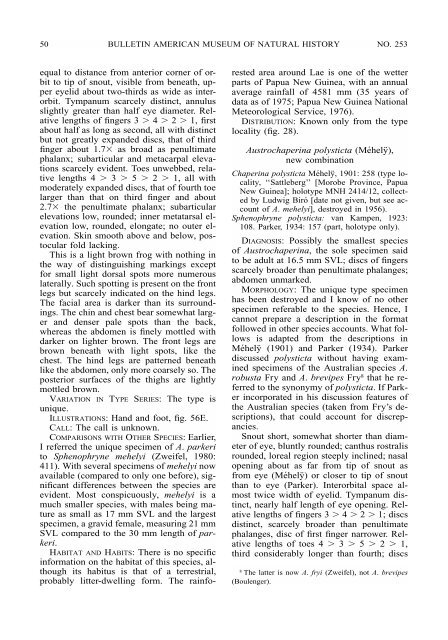SPHENOPHRYNE - American Museum of Natural History
SPHENOPHRYNE - American Museum of Natural History
SPHENOPHRYNE - American Museum of Natural History
You also want an ePaper? Increase the reach of your titles
YUMPU automatically turns print PDFs into web optimized ePapers that Google loves.
50 BULLETIN AMERICAN MUSEUM OF NATURAL HISTORY NO. 253<br />
equal to distance from anterior corner <strong>of</strong> orbit<br />
to tip <strong>of</strong> snout, visible from beneath, upper<br />
eyelid about two-thirds as wide as interorbit.<br />
Tympanum scarcely distinct, annulus<br />
slightly greater than half eye diameter. Relative<br />
lengths <strong>of</strong> fingers 3 4 2 1, first<br />
about half as long as second, all with distinct<br />
but not greatly expanded discs, that <strong>of</strong> third<br />
finger about 1.7 as broad as penultimate<br />
phalanx; subarticular and metacarpal elevations<br />
scarcely evident. Toes unwebbed, relative<br />
lengths 4 3 5 2 1, all with<br />
moderately expanded discs, that <strong>of</strong> fourth toe<br />
larger than that on third finger and about<br />
2.7 the penultimate phalanx; subarticular<br />
elevations low, rounded; inner metatarsal elevation<br />
low, rounded, elongate; no outer elevation.<br />
Skin smooth above and below, postocular<br />
fold lacking.<br />
This is a light brown frog with nothing in<br />
the way <strong>of</strong> distinguishing markings except<br />
for small light dorsal spots more numerous<br />
laterally. Such spotting is present on the front<br />
legs but scarcely indicated on the hind legs.<br />
The facial area is darker than its surroundings.<br />
The chin and chest bear somewhat larger<br />
and denser pale spots than the back,<br />
whereas the abdomen is finely mottled with<br />
darker on lighter brown. The front legs are<br />
brown beneath with light spots, like the<br />
chest. The hind legs are patterned beneath<br />
like the abdomen, only more coarsely so. The<br />
posterior surfaces <strong>of</strong> the thighs are lightly<br />
mottled brown.<br />
VARIATION IN TYPE SERIES: The type is<br />
unique.<br />
ILLUSTRATIONS: Hand and foot, fig. 56E.<br />
CALL: The call is unknown.<br />
COMPARISONS WITH OTHER SPECIES: Earlier,<br />
I referred the unique specimen <strong>of</strong> A. parkeri<br />
to Sphenophryne mehelyi (Zweifel, 1980:<br />
411). With several specimens <strong>of</strong> mehelyi now<br />
available (compared to only one before), significant<br />
differences between the species are<br />
evident. Most conspicuously, mehelyi is a<br />
much smaller species, with males being mature<br />
as small as 17 mm SVL and the largest<br />
specimen, a gravid female, measuring 21 mm<br />
SVL compared to the 30 mm length <strong>of</strong> parkeri.<br />
HABITAT AND HABITS: There is no specific<br />
information on the habitat <strong>of</strong> this species, although<br />
its habitus is that <strong>of</strong> a terrestrial,<br />
probably litter-dwelling form. The rainfo-<br />
rested area around Lae is one <strong>of</strong> the wetter<br />
parts <strong>of</strong> Papua New Guinea, with an annual<br />
average rainfall <strong>of</strong> 4581 mm (35 years <strong>of</strong><br />
data as <strong>of</strong> 1975; Papua New Guinea National<br />
Meteorological Service, 1976).<br />
DISTRIBUTION: Known only from the type<br />
locality (fig. 28).<br />
Austrochaperina polysticta (Méhely¨),<br />
new combination<br />
Chaperina polysticta Méhely¨, 1901: 258 (type locality,<br />
‘‘Sattleberg’’ [Morobe Province, Papua<br />
New Guinea]; holotype MNH 2414/12, collected<br />
by Ludwig Biró [date not given, but see account<br />
<strong>of</strong> A. mehelyi], destroyed in 1956).<br />
Sphenophryne polysticta: van Kampen, 1923:<br />
108. Parker, 1934: 157 (part, holotype only).<br />
DIAGNOSIS: Possibly the smallest species<br />
<strong>of</strong> Austrochaperina, the sole specimen said<br />
to be adult at 16.5 mm SVL; discs <strong>of</strong> fingers<br />
scarcely broader than penultimate phalanges;<br />
abdomen unmarked.<br />
MORPHOLOGY: The unique type specimen<br />
has been destroyed and I know <strong>of</strong> no other<br />
specimen referable to the species. Hence, I<br />
cannot prepare a description in the format<br />
followed in other species accounts. What follows<br />
is adapted from the descriptions in<br />
Méhely¨ (1901) and Parker (1934). Parker<br />
discussed polysticta without having examined<br />
specimens <strong>of</strong> the Australian species A.<br />
robusta Fry and A. brevipes Fry8 that he referred<br />
to the synonymy <strong>of</strong> polysticta. If Parker<br />
incorporated in his discussion features <strong>of</strong><br />
the Australian species (taken from Fry’s descriptions),<br />
that could account for discrepancies.<br />
Snout short, somewhat shorter than diameter<br />
<strong>of</strong> eye, bluntly rounded; canthus rostralis<br />
rounded, loreal region steeply inclined; nasal<br />
opening about as far from tip <strong>of</strong> snout as<br />
from eye (Méhely¨) or closer to tip <strong>of</strong> snout<br />
than to eye (Parker). Interorbital space almost<br />
twice width <strong>of</strong> eyelid. Tympanum distinct,<br />
nearly half length <strong>of</strong> eye opening. Relative<br />
lengths <strong>of</strong> fingers 3 4 2 1; discs<br />
distinct, scarcely broader than penultimate<br />
phalanges, disc <strong>of</strong> first finger narrower. Relative<br />
lengths <strong>of</strong> toes 4 3 5 2 1,<br />
third considerably longer than fourth; discs<br />
8 The latter is now A. fryi (Zweifel), not A. brevipes<br />
(Boulenger).
















